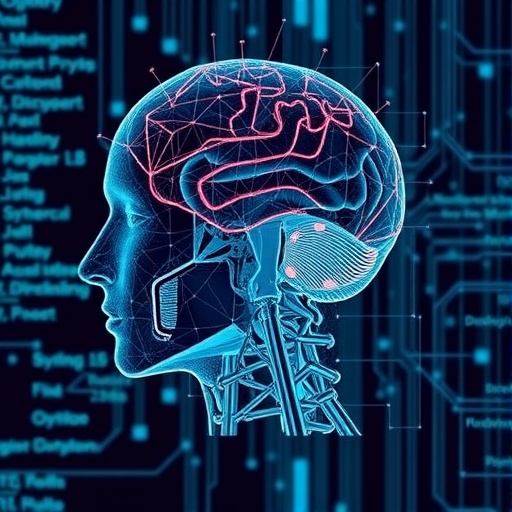In a groundbreaking development poised to revolutionize the diagnosis of psychiatric disorders, scientists have unveiled an open-access dataset alongside cutting-edge machine learning algorithms centered on the Niacin Skin-Flushing Response (NSR). This physiological biomarker, long recognized for its potential in mental health diagnostics, has traditionally been constrained by the limitations of conventional statistical methodologies. However, with the integration of artificial intelligence (AI), researchers are breaking new ground, delivering unprecedented accuracy and speed in mental health screening.
Niacin skin flushing manifests as redness and warmth on the skin after the application of niacin, a form of vitamin B3. This response has been identified as an objective physiological marker correlated with a spectrum of psychiatric conditions such as depression, bipolar disorder, and schizophrenia. Despite its recognized diagnostic promise, clinical application was hindered by subjective interpretation and limited analytical tools. Now, leveraging AI and machine learning (ML), this barrier is being dismantled with the presentation of a comprehensive dataset combined with an advanced analytical framework.
The innovative research team introduced the world’s first publicly available dataset tailored for AI-centric studies of NSR. Comprising 600 high-fidelity images obtained from 120 individuals, this dataset represents a diverse cohort that includes healthy controls as well as patients diagnosed with various psychiatric illnesses. This resource is expected to serve as a foundational asset for future explorations into biomarker analysis and psychiatric diagnostics, significantly broadening research horizons.
Central to this study is a sophisticated machine learning pipeline combining deep learning and classical classification techniques. A novel Efficient-Unet architecture, a state-of-the-art neural network model specialized for image segmentation tasks, was employed to delineate NSR-affected skin regions with extraordinary precision. This process was enhanced by runtime data augmentation strategies, bolstering the model’s robustness by simulating various imaging conditions and reducing overfitting. The image dataset was meticulously partitioned into training, validation, and testing subsets to optimize performance and evaluate generalizability.
Subsequent to accurate segmentation, a Support Vector Machine (SVM) classifier was tasked with delineating psychiatric conditions based on features extracted from the NSR regions. In a bid to address class imbalance, an endemic issue in medical datasets where certain conditions are underrepresented, the researchers implemented Synthetic Minority Over-sampling Technique (SMOTE). This approach synthetically amplifies minority class data points, thereby enhancing classification fairness and model reliability. Coupled with rigorous five-fold cross-validation and hyperparameter tuning, the classifier achieved balanced and optimized diagnostic accuracy.
The diagnostic capability of the developed AI system is particularly remarkable due to its device-agnostic design. Unlike prior studies restricted by reliance on specific imaging instruments, this approach demonstrated steadfast performance irrespective of image acquisition devices. Such device independence is pivotal for the potential translation of this technology into diverse clinical and field settings worldwide, where equipment heterogeneity often acts as a barrier to deploying AI tools.
Quantitative results from the study reveal that sensitivity — the ability to correctly identify true positive cases — ranged between 60.0% and 65.0%. Specificity, reflecting true negative rates, exhibited even more impressive figures between 75.0% and 88.3%. These metrics were consistent across a variety of psychiatric diagnoses, underscoring the versatility and broad applicability of the model. Importantly, these performance indicators represent a palpable advancement over traditional diagnostic methods that often suffer from subjectivity and limited quantitative assessment.
Beyond its technical achievements, the study stands out in its commitment to transparency and scientific collaboration through the release of the open dataset. Open data initiatives are vital to accelerate innovation, allowing researchers globally to validate findings, develop improved models, and expand the understanding of NSR’s diagnostic potential. This ethos echoes the growing trend within medical AI research towards democratizing data access to foster reproducibility and inclusivity.
Moreover, the method’s potential to outperform human diagnosticians in both speed and accuracy heralds a paradigm shift in psychiatric evaluation. The objective quantification of a physiological response via machine learning bypasses the inconsistencies often encountered in subjective clinical assessments. Faster, more reliable screenings can translate into earlier interventions, improved patient care, and ultimately better prognoses in mental health treatment.
From a clinical implementation standpoint, the device-independent nature of the algorithm reduces cost and complexity, facilitating its integration into existing healthcare workflows. Digital images captured using simple, cost-effective devices or smartphones could be analyzed using the established AI pipeline, democratizing access to advanced diagnostic tools even in resource-limited environments.
While the work sets a new benchmark, it also paves the way for future research into refining the models further, incorporating multimodal data, and extending applicability to other psychiatric and neurological conditions. Continued efforts in augmenting dataset diversity and addressing potential biases can strengthen the system’s universality and ensure equitable healthcare delivery.
This study, published in BMC Psychiatry, encapsulates a transformative intersection of neurobiology, computational sciences, and digital health innovation. By harnessing the subtleties of the Niacin Skin-Flushing Response through machine learning, researchers have charted a promising course towards objective, scalable, and accessible mental health diagnostics for a global population increasingly burdened by psychiatric disorders.
In conclusion, the integration of advanced AI algorithms with physiological biomarkers like NSR establishes a novel diagnostic paradigm, offering a compelling alternative to traditional psychiatric assessments. The open dataset and sophisticated machine learning pipeline not only enhance diagnostic precision but also democratize mental health screening technologies. As the scientific community embraces these tools, the potential to reduce diagnostic uncertainty and to improve patient outcomes worldwide becomes a tangible reality in the near future.
Subject of Research: Machine learning-based diagnostic screening of psychiatric disorders using Niacin Skin-Flushing Response (NSR).
Article Title: An open dataset and machine learning algorithms for Niacin Skin-Flushing Response based screening of psychiatric disorders.
Article References:
Lyu, X., Goperma, R., Wang, D. et al. An open dataset and machine learning algorithms for Niacin Skin-Flushing Response based screening of psychiatric disorders. BMC Psychiatry 25, 757 (2025). https://doi.org/10.1186/s12888-025-07196-2
Image Credits: AI Generated




